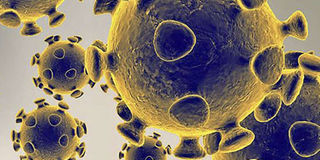Breaking News: KDF chopper crash kills five in West Pokot
Explainer: How coronavirus ravages human body

An illustration image obtained February 27, 2020 courtesy of the US Food and Drug Administration shows the coronavirus,COVID-19. PHOTO | AFP
What you need to know:
When the virus raids lung cells, first it affects mucus— the lubricant that keeps the breathing organ moist and protects it from pathogens.
Like SARS before it, the virus attacks and destroys cilia cells, which are tiny cells in the lungs that help to clear pollen and viruses that may infect the air purifier.
When the cilia are dead, the lungs are exposed to infections.
Much remains unknown about the new coronavirus that continues ravage humanity across the world.
Researchers are still trying to understand the origin of the virus and to piece together its workings, which will help them to develop a vaccine against it.
Data from Worldometer, an online-based global statistics tracker, show that as at March 25, 423,621 people had been infected and 18,912 others died from the complications of a virus that scientists say is 23 times more fatal that common flu.
So far, the virus has killed more people than SARS and MERS combined.
Even so, the world could be staring at a darker future, according to a leading epidemiologist at the University of Hong Kong, who said in mid-February that if unchecked, the virus could infect 60 per cent of the world’s population.
But what specifically does the virus do to the body and individual body parts?
• Lungs
Being a respiratory disease, coronavirus begins and ends in the lungs for most patients.
When the virus raids lung cells, first it affects mucus— the lubricant that keeps the breathing organ moist and protects it from pathogens.
Like SARS before it, the virus attacks and destroys cilia cells, which are tiny cells in the lungs that help to clear pollen and viruses that may infect the air purifier.
When the cilia are dead, the lungs are exposed to infections.
This explains why many patients of Covid-19 have suffered from pneumonia and breathing problems.
This events trigger the immune system to respond. Immune cells are reproduced in the body to stave off the invasion by the virus, to clear the lungs and repair the damage.
Associate professor Matthew Frieman of the University of Maryland’s School of Medicine notes that the body may overproduce the immune cells, which end up damaging and killing even the normal healthy tissue.
This lung damage results in a worsened case of pneumonia, even respiratory failure in far lethal cases.
‘‘In severe cases, you basically flood your lungs and you can’t breathe. That’s how people are dying,’’ explains Frieman, who studies highly pathogenic coronaviruses.
While one may survive, the condition leaves them with permanent lung damage.
In this case, a patient may require to use ventilators to aid them in breathing.
• Stomach
To most people, there’s no connection between a respiratory virus and the gut.
In earlier cases involving SARS and MERS though, 25 per cent of patients experienced diarrhoea and abdominal discomfort.
Given the similarities between these illnesses and the latest outbreak, researchers are leaving nothing to chance.
When a virus invades the body, it relies on receptors (proteins on the outer side of cells).
While some viruses choose which cells to invade, others penetrate any cell in their way.
These viruses then access cells in the small and large intestines and the colon, damaging them and causing leakage that leaves the body in form of diarrhoea.
So far, two studies, including one published in the New England Journal of Medicine, show that the virus has been confirmed in stool samples.
• Liver damage
Once a virus gets into the bloodstream, it is carried to all parts of the body.
The liver’s cardinal job is to process blood and to filter out toxins.
When the body is functioning optimally, liver cells die and release enzymes into the bloodstream before generating new cells to carry on the work.
Scientists suspect that coronavirus might be infecting the liver, reproducing the cells and killing them itself, which could lead to liver failure.
Liver failure is, however, not the main killer of Covid-19 or SARS patients.
• Kidney
Kidney’s main job is to filter blood.
To do this, they use units called nephrons, which sieve the blood and return the desirable contents into the body while the waste goes to the bladder and is passed out as urine.
While doing this, this tubular cells may trap the virus, causing damage to themselves.
The virus may even start to replicate within the unit, resulting in injury.
Coronavirus is largely associated with renal injury among its patients, just like in SARS and MERS.
A 2005 study showed that SARS killed 91 per cent patients with acute renal impairment.
• Blood
When a foreign body is detected in your system, white blood cells recruit immune cells which then kill off the infected cells as a way to rescue the rest of the tissues.
During a severe coronavirus infection, the body experiences a hyperactive immune response.
The immune system sends an overload of cytokines (the body’s alarm bells) to the lungs to fight off the virus.
Researchers call this a cytokine storm.
When there’s a release, the soldiers attack the healthy tissues too, causing inflammation that renders blood vessels in the lungs weak and allows fluids to permeate the air sacs.
The result is fatal as you start ‘‘bleeding out of your blood vessels’’. This also diminishes the ability of vessels to transport oxygen to other parts of the body, which could potentially lead to multiple organ failure.





